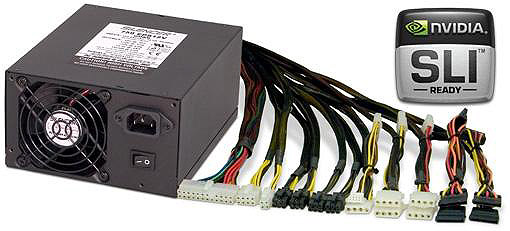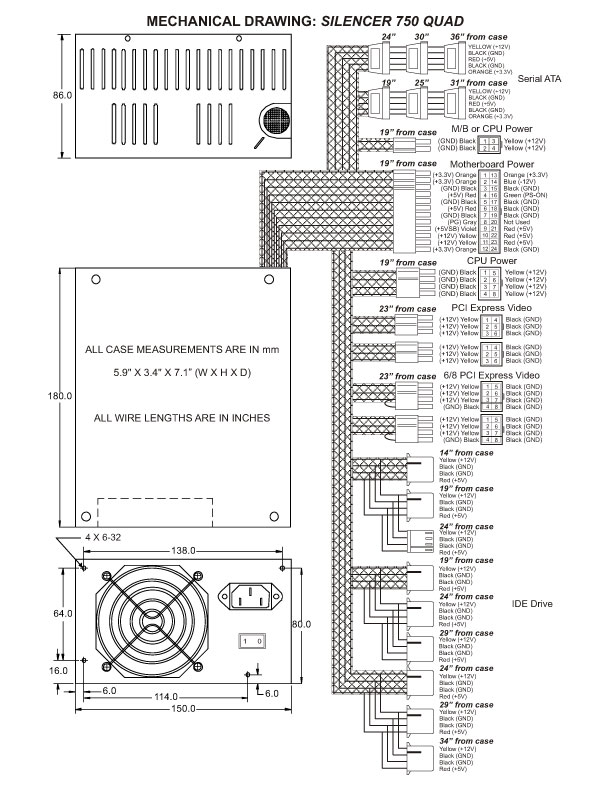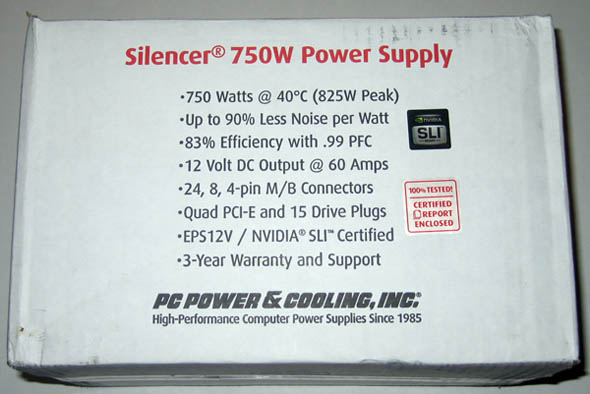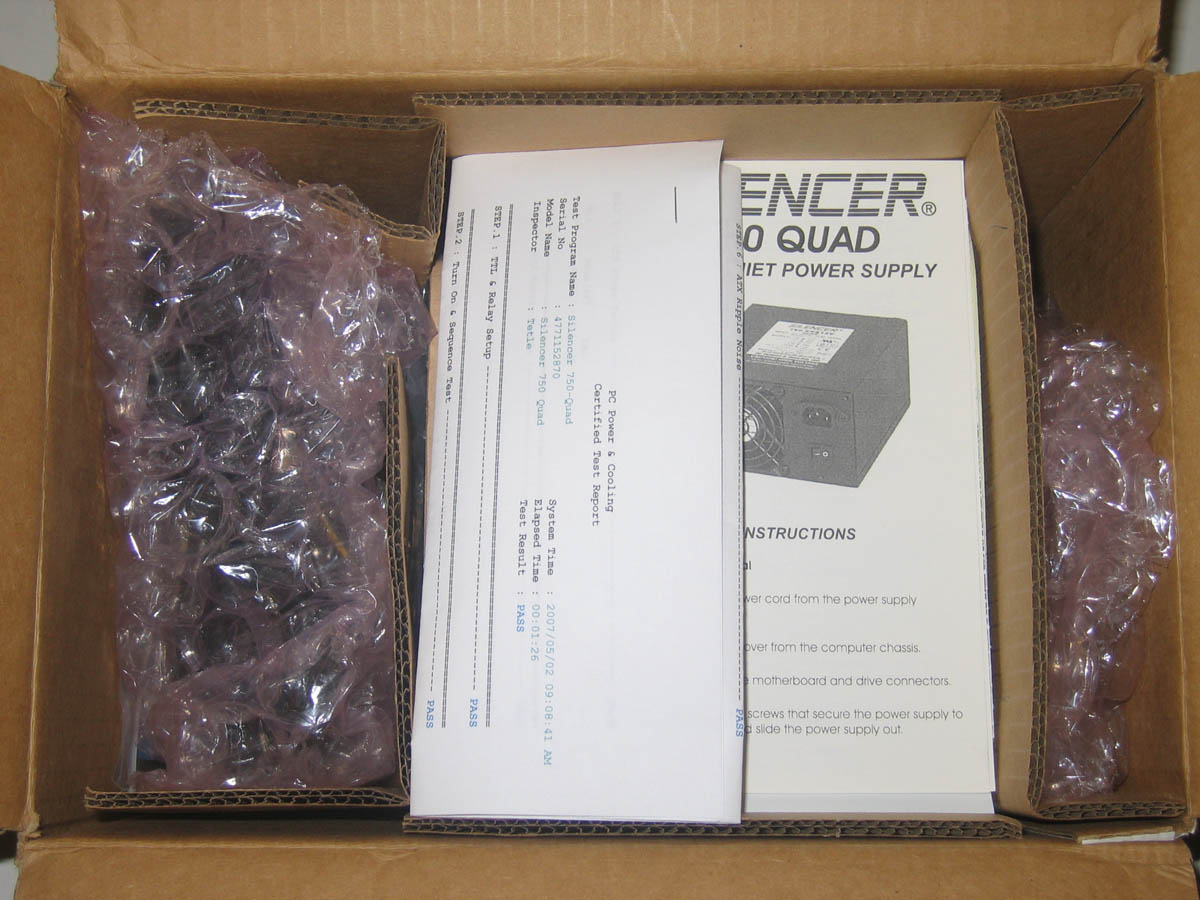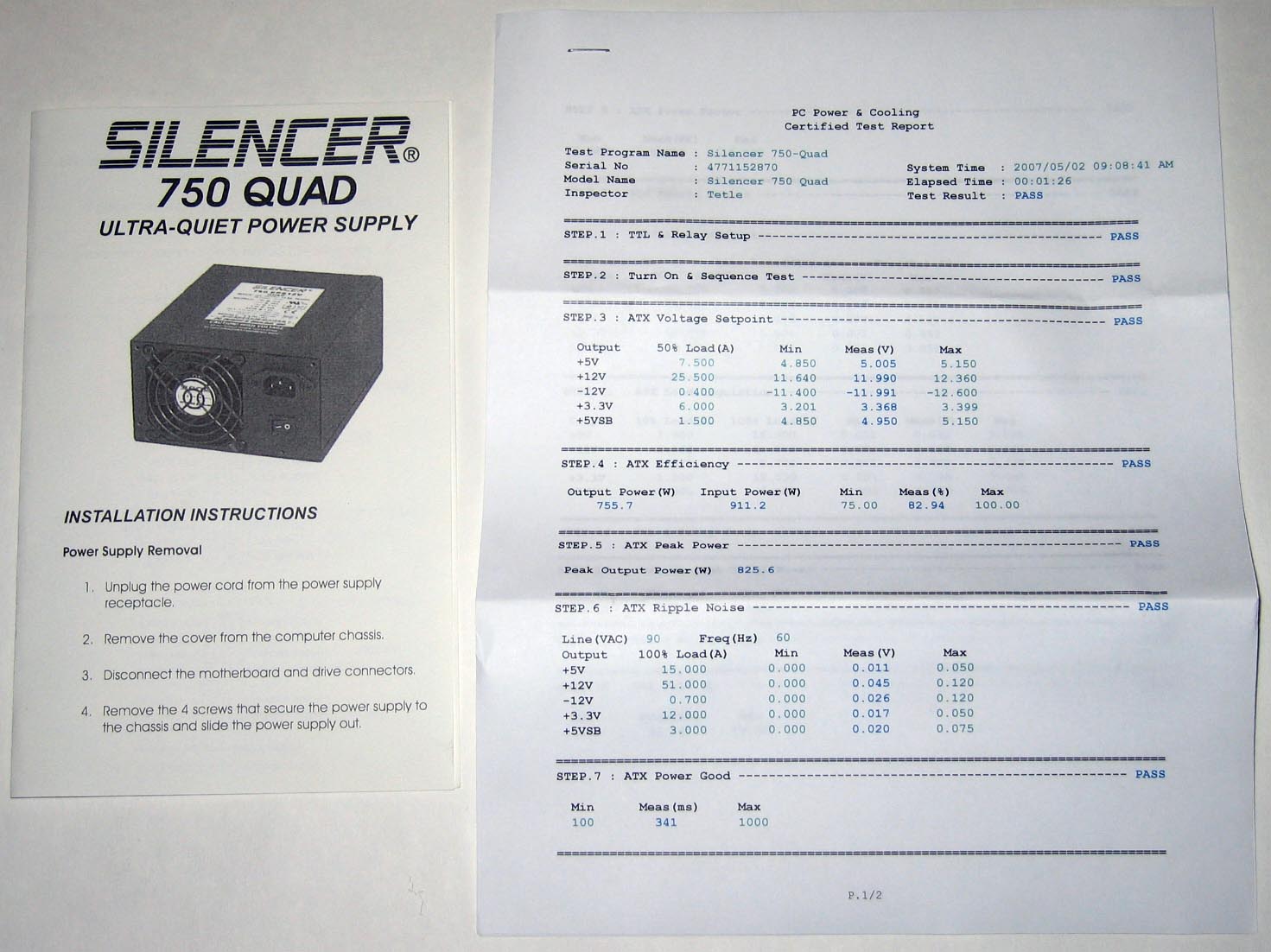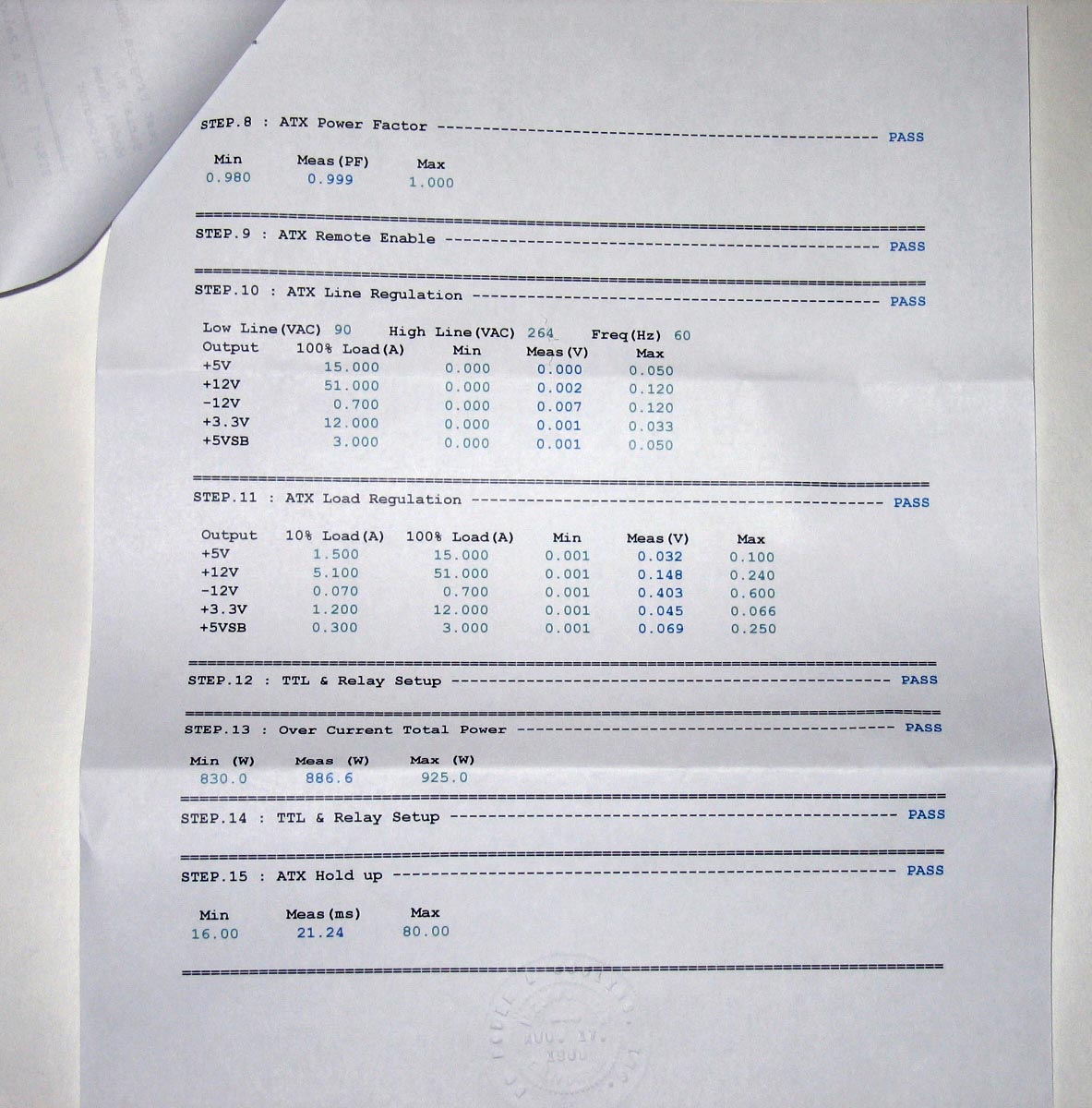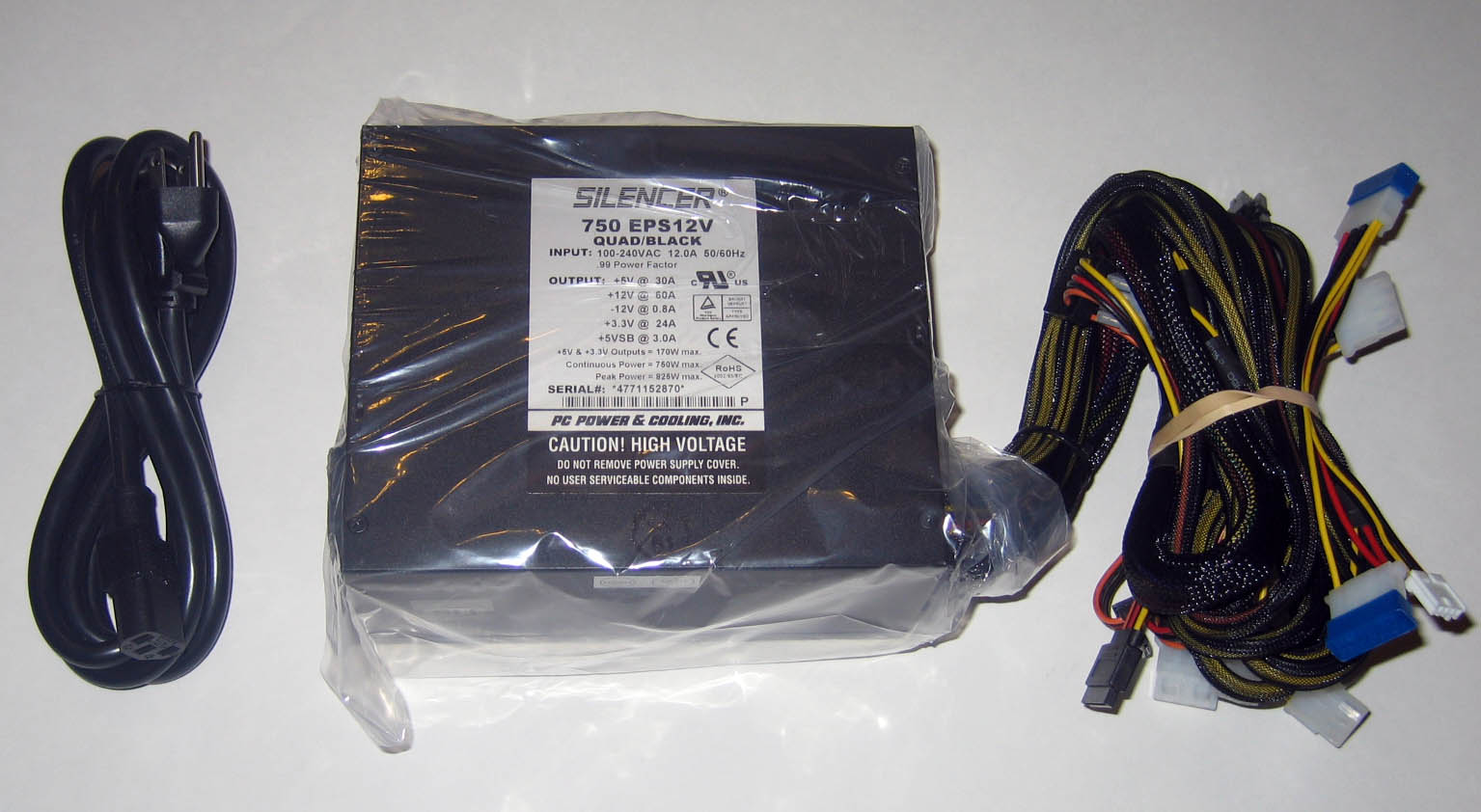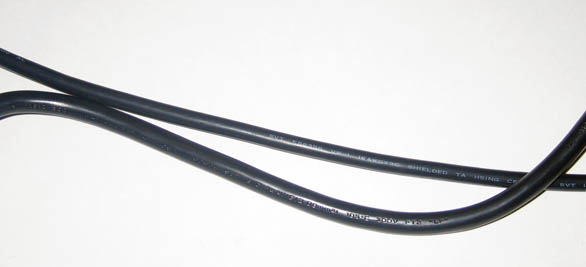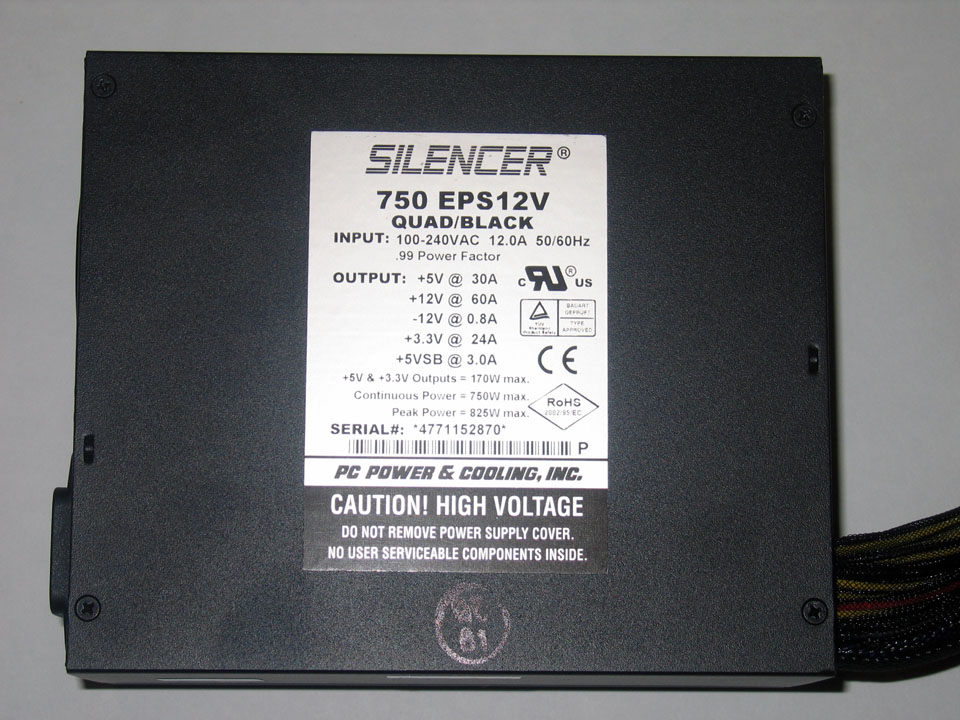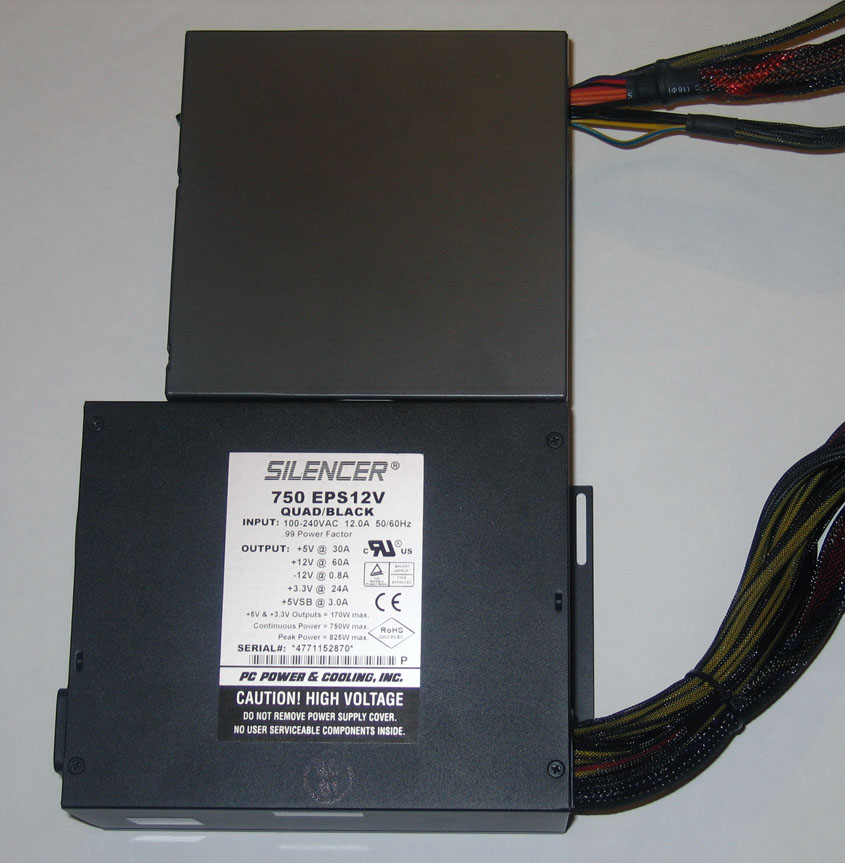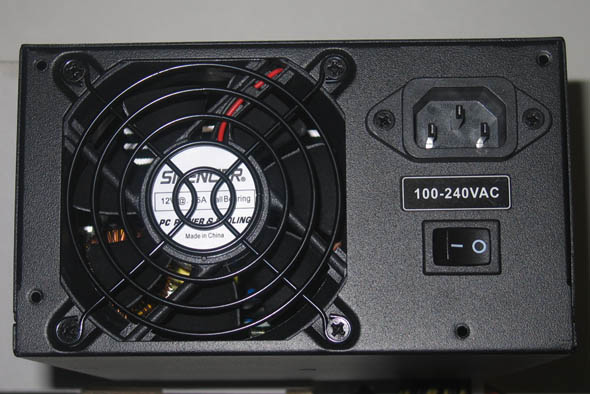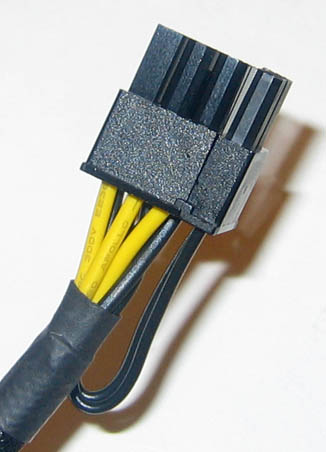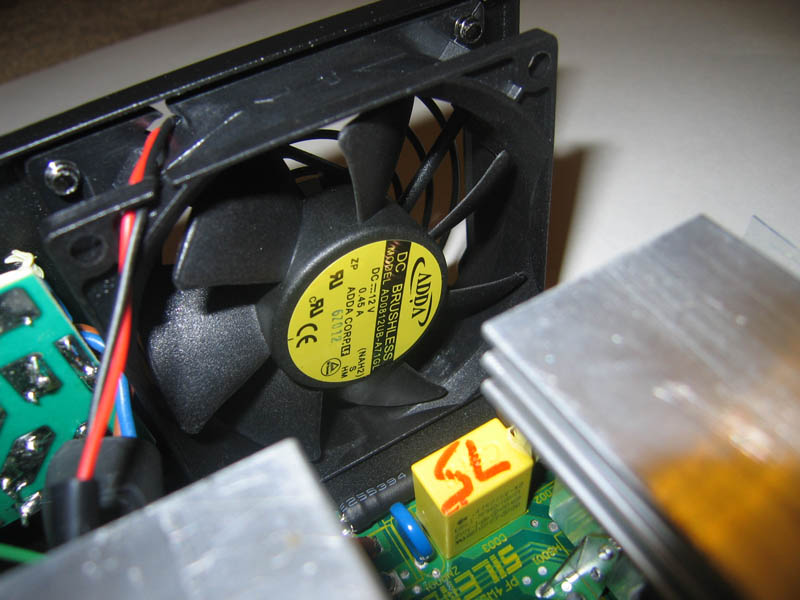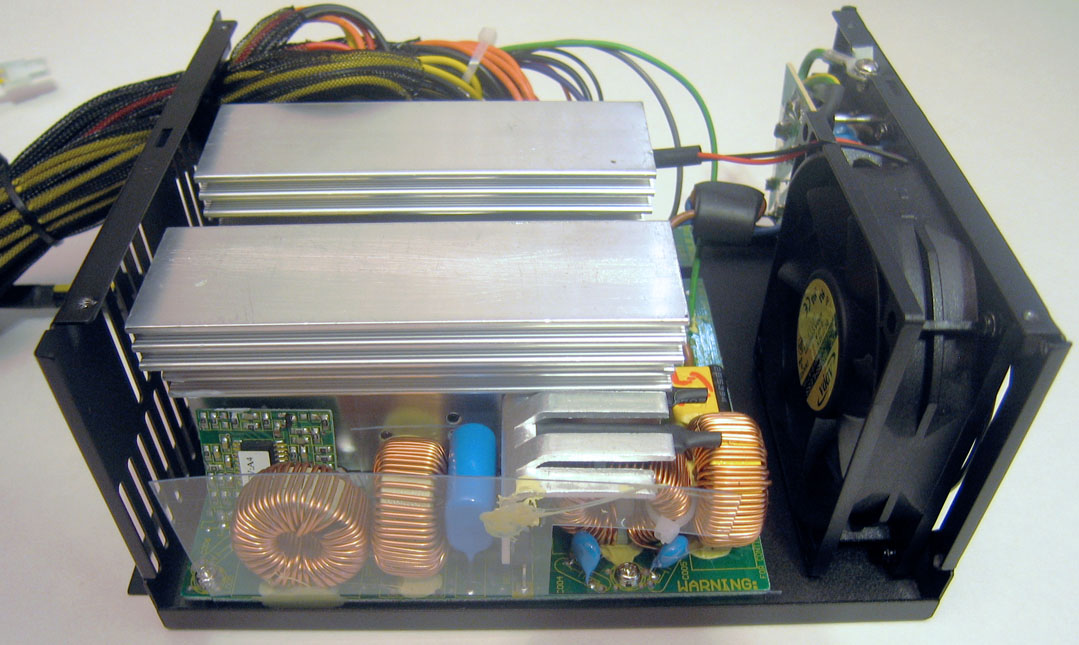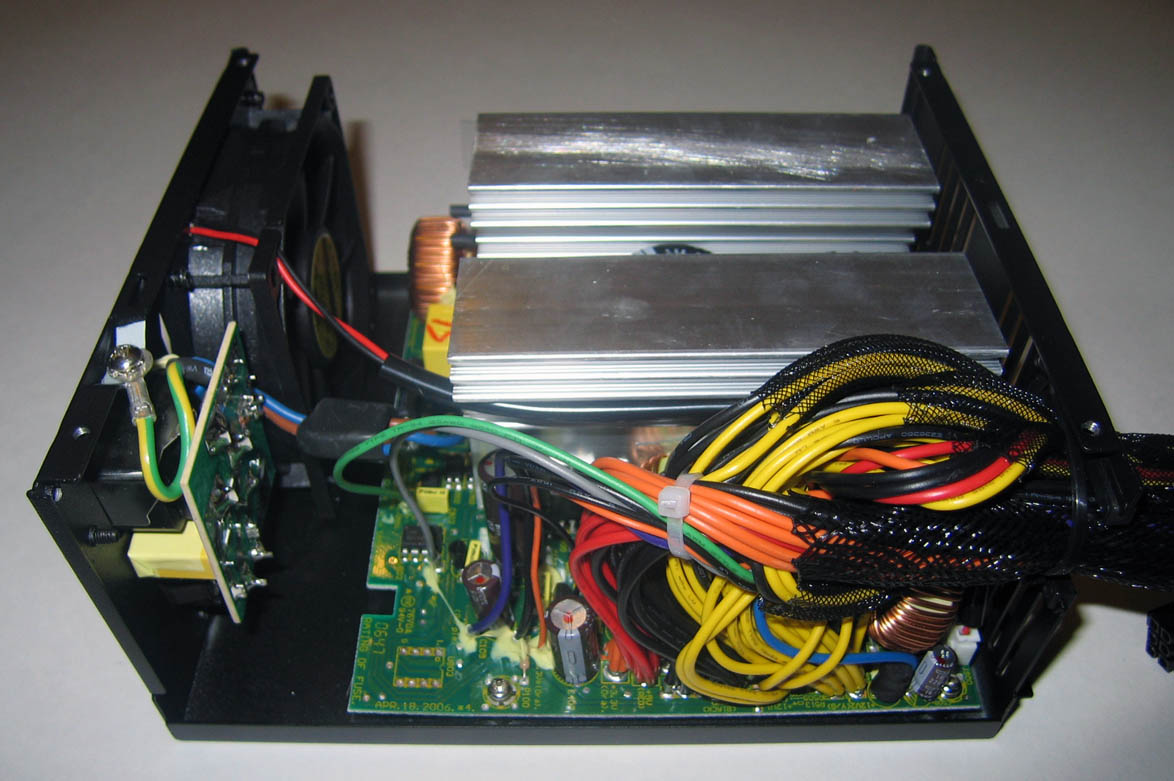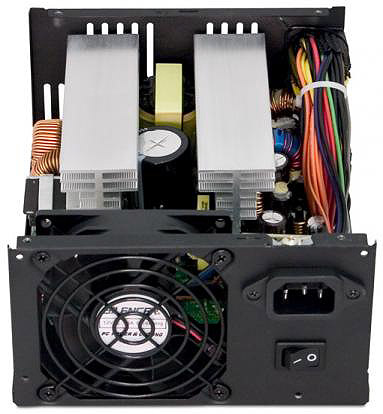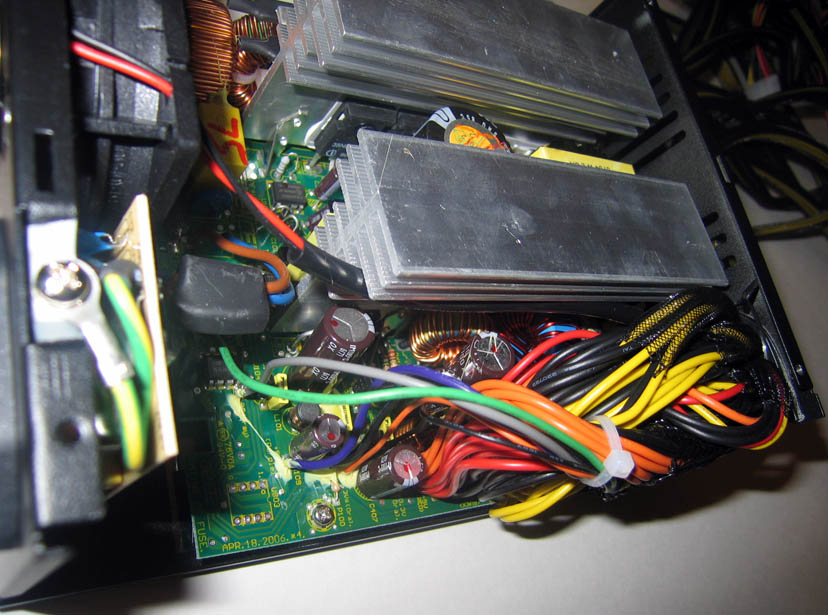PC Power & Cooling has once again updated their power supplies to bring you a true Crossfire HD 2900 or SLI 8800 Ultra capable power supply with the 750 Watt Quad Silencer. With a few surprises up its sleeve such as a massive single 60A 12V rail and the optional 12-Point Power Supply Certification report this PSU certainly deserves to be on your next list of potential power supplies.
INTRODUCTION
Not so long ago a 400 watt power supply was considered plenty, and then quickly 500 watts became the answer to the commonly asked question of what the average Jane or Joe should use in their upcoming computer build. These days 620 watts or slightly more seems to be the “better safe than sorry” answer, but is all this power really necessary? Sure almost anyone can have four times the CPU’s or even four times the GPU’s than back when 400 watt power supplies were considered powerful, but that doesn’t mean the typical computer user has a Quad-core CPU (or two!) let alone Quad-SLI or Tri-Crossfire.
Is 620 watts even a reachable figure for an average computer packing a single GPU or is it just marketing hype? For this review we will answer those questions while taking a look at the 750 watt Quad Silencer power supply from a manufacturer that started it all with their well known One-Kilowatt PSU, PC Power & Cooling.
PC Power & Cooling has long held an almost single-minded devotion to quality first, with standards, aesthetics, and industry trends all regulated to the rather crowded back seat. That isn’t to say they don’t meet standards, PC P&C has typically exceeded whatever standards currently exist at the time. Their refusal to meet Intel’s ATX 12V power supply specifications which call for the breaking up of the +12v rail into individual 20A limited rails is perhaps the most notable–and perhaps one of the biggest features–of the PC Power & Cooling Quad Silencer 750W.
More recent was the news that PC Power & Cooling, a long time privately owned company, was purchased by OCZ. OCZ is perhaps best known for their memory products although they have been offering their own lines of power supplies, aftermarket coolers and even recently NVIDIA graphics cards. Realizing the high value placed on anything with the PC Power & Cooling name OCZ has stated they have no plans to change either PC P&C’s name or current product offering. As news of the acquisition spread across the internet OCZ was also extremely quick to go on record dispelling notions that OCZ would start cutting corners in current models to lower production costs or change PC Power & Cooling’s commitment to quality first. We of course look foreward to seeing what PC P&C has planned for the future now that they have the strong presence and backing of OCZ
ABOUT PC P&C
On April 19,1985, PC Power & Cooling began operations in a small warehouse just outside of San Diego, CA. Founded by Doug Dodson, a commodity trader and electronic hobbyist, the company’s first products were custom fans to cool and quiet computers.
In 1986, the company introduced its Silencer 150 and Turbo-Cool 200, the industry’s first ultra-quiet and high-performance power supplies. Other high-end products followed, the reviews were great, and the company continued to grow. In 1991, the company moved to a modern facility in Carlsbad, CA.
Over the last 22 years, PC Power & Cooling has produced many innovative products including: the first CPU cooler, the first PC heat alarm, the first independently-regulated PC power supply, the first redundant power system, the first NVIDIA-certified SLI supply, the first One Kilowatt computer power supply, and the first power supply with its own certified test report (Turbo-Cool 1KW).
PC Power & Cooling takes pride in its loyal and knowledgeable customer base, its ultra-reliable product line, its professional and friendly staff, and its financial strength.
SPECIFICATIONS
There are no windows, multiple fans, single huge 140mm fans, modular cabling, flashy exterior, or last but not least shortage of connectors with the Black Quad Silencer, just as with its more famous One-KiloWatt big brother. Instead they can now expect to find Crossfire support for the latest ATI cards—including two new 6+2pin connectors ATI HD 2900XT cards require—without sacrificing the ability to use two 8800 Ultras in SLI. PC Power & Cooling presently offers the Black, Red, and Copper colors for the Quad Silencer. Oddly while only the Red model is advertised with Crossfire support, the Black and Copper lines of Silencers have been quietly updated to also fully support both a pair of 8800GTX’s in SLI or a pair of HD 2900XT’s in Crossfire.
Instead of simply pasting in the marketing-speak that often shares a lot in common with politician-speak, I will pause here to highlight some key aspects that every single power supply buyer needs to look for. Not that PC Power & Cooling has much marketing-speak to paste actually, just a whole lot of product information instead.
|
Feature/Specification |
Silencer 750 Quad (Black) Technical Specifications | |
|
AC Input
|
||
|
Operating Range
|
90-264 VAC
.99 power factor
|
|
|
Frequency
|
47-63Hz
|
|
|
Current
|
12A
|
|
|
Efficiency
|
83%
|
|
|
EMI
|
FCC-B, CE
|
|
|
DC Output
|
||
|
Output
|
+5V @ 30A
+12V @ 60A -12V @ 0.8A +3.3V @ 24A +5VSB @ 3A continuous = 750W peak = 825W |
|
|
Regulation
|
3% (+3.3V, +5V, +12V)
5% (-12V) |
|
|
Ripple
|
1% (p-p)
|
|
|
Hold Time
|
16ms
|
|
|
PG Delay
|
300ms
|
|
|
Safety
|
||
|
OV Protection
|
+3.3V, +5V, +12V
|
|
|
OC Protection
|
135% OPP
|
|
|
Agency Approval
|
UL/ULC/CE/CB/RoHS
|
|
|
Environmental
|
||
|
Temperature
|
0° – 40°C
|
|
|
Humidity
|
20% – 80% RH
|
|
|
Fan Type
|
22 – 55 CFM ball-bearing
|
|
|
Noise |
26 – 40dB(A) |
|
|
Miscellaneous |
||
|
Compatibility |
Black: NVIDIA SLI Certified (Dual 8800 GTX)
Red: ATI CrossFire Certified (Dual HD 2900XT)
|
|
|
M/B Connectors |
24-pin, 8-pin, 4-pin, two 6-pin PCI-E, |
|
|
Drive Connectors |
15 (6 SATA, 8 Molex, 1 mini) |
|
|
MTBF |
100,000 hours |
|
|
Dimensions/Harness |
||
|
Power Cord |
6′ 14AWG (incl.) |
|
|
Warranty |
||
First stop is the temperature range. Some PSU manufacturers intentionally use an unrealistically low temperature range to make their power supply hold up better. What happens is as a PSU’s environmental temperature rises it will become less efficient while the strain on the components quickly increases, usually to ill effect for the output voltages. The listed 40c range here is not quite at the 50c mark that we would wish to see but it is acceptable. Any PSU rated to operate only below the 40c mark should be regarded with obvious skepticism.
Second, under Output one should look for a “continuous” rating. According to the specs the Quad Silencer has a 750 watt continuous operating rating, which translated means it is fully capable of delivering a sustained 100% load. Not all power supplies list a continuous number, let alone to the full wattage claims of the unit. Instead the cheaper power supply units will give a “Peak” rating that the PSU is only capable of operating at for just mere milliseconds. The 750watt Quad Silencer has a very respectable Peak rating of 825 watts for a total hold up time of 16ms which gives a more than fair safety margin.
Lastly, we look at the 12V rail. Yes, singular, as in the 750 watt Quad Silencer has a single gargantuan 60A rated 12V rail! It used to be that single 12V rail was once shunned, however single 12V rails are slowly coming back into vogue as the disadvantages to splitting the 12V are becoming better known. In a nutshell splitting the 12V means each 12V is “capped” with a line limiter, effectively limiting each individual 12V rail to only a small portion of the total power. So if the CPU uses only a portion of the 12V1 rail and the two GPUs need more power then the 12V2 and 12V3 rails can provide, they cannot use the unused power that is stuck on the 12V1 rail. While my example is horrible one can find a better example directly from PC Power & Cooling’s excellent Power Supply Myths Exposed article. Despite that they would have an obvious interest in marketing their own products, the overall majority of the article is a refreshingly frank look at some power supply misconceptions and only underscores PC P&C’s confidence in the high quality they put into their own power supplies.
While we will be sure to take a very close look at how well the single 80mm exhaust fan cools this unit, any power supply with Active PFC and a very high efficiency rating will require less cooling. This is because less power will be lost to heat in the AC to DC conversion process, as compared to a power supply with a lower efficiency rating which would waste more AC current from the outlet just to output the same amount of DC current to the computer.
Even so the single 80mm fan on the Quad Silencer would still seem impractical, but keep in mind almost all 120mm and 140mm fan equipped power supplies use a plastic shield to partially block these fans in order to force airflow to where it needs to go. Using the plastic shield will obviously block a large percentage of the increased airflow; most shields cover as much as 30-50% of the fan! With both these facts in mind a single 80mm fan no longer seems quite as out of place despite the large 750 watt rating of this unit. However the final proof will be in the performance, er pudding as they say.
Readers interested in knowing the various cable lengths and layout need look no further than the diagram below which shows the current revision of the Quad Silencer.
PACKAGE & CONTENTS
At first it looks like any other power supply box, until you realize it isn’t. Instead of the typical store-shelf thin cardboard box the power supply arrived in a solid, well secured shipping grade box. The internal specifications are well listed on both sides along with stickers for SLI support and that a certified test report is included, but more on that important detail later. Also important to note is after this unit was received before PC Power & Cooling changed their 3-Year warranty to a 5-Year warranty policy starting from the date of purchase (Current owners are included in the extension). Considering the typical computer power supply is doing well to survive past three years this is a generous figure and one we especially like to see from manufacturers. Perhaps even more astonishing though was the the confident announcement their Turbo-Cool line of power supplies will have their warranty extended from 5 to 7 years.
Conducted on our $100,000 Chroma 8000 ATE, the 12-point test includes automatic retrieval of the PSU’s serial number, voltage setpoint, ripple, power factor, efficiency, line and load regulation, protection circuit evaluation, and peak power output. At the conclusion of the test, a two page report is generated and the results are certified.
Enthusiasts that are interested in knowing every minute detail about their own specific power supply just may find the extra $20 cost of this report worthwhile. I am likely biased, but I would say that I certainly would consider it worthwhile.The Chroma 8000 ATE is exactly the kind of professional equipment that is needed to properly conduct and test a power supply, unfortunately $100,000 is just a little more than Bjorn3D’s (And the majority of other fellow review website’s) operating budgets.
Now we arrive at the more interesting contents, the unit and accessories! Er, or make that single large accessory, in this case. A case badge or even a couple velcro straps to compensate for the lack of modular cables would have been a small but likely appreciated gesture for most potential buyers.
At first it may appear to be just another power cord, until you attempt to straighten it out! PC Power & Cooling includes a 6-foot 14AWG cord with all of their high performance power supplies. They feel the traditional power cord is not of a sufficient gauge to warrant an acceptable safety margin. The typical power cords connected to your monitor and computer are only 16 AWG. The smaller the gauge number the thicker the wire and cable. Ignoring that the typical home AC outlet is a much larger risk as a point of failure it is still nice to have the additional safety margin, even if the cord itself is rather more inflexible to work with at first.
On the back of the basic instruction manual PC Power & Cooling has included the terms of their now 5-Year warranty and support guarantee. Again since this review sample arrived before the original warranty was extended it is a safe bet PC Power & Cooling has updated their product packaging and relevant documents already. Or perhaps I should say completely redesigned.

A CLOSER LOOK
Unwrapping the unit we are greeted with a very nice matte black finish. Photographing the unit brings the grain of the metal out just a bit more than it appears in person, but I happen to especially like the no-nonsense appearance of this power supply. Not to mention fingerprints are almost a non-issue. However for those that prefer more pizzazz or bling I would point towards the Copper or Crossfire Red models.
Also in the typical PC Power & Cooling fashion of avoiding common industry specifications is the non-standard sticker. While I would commend PC Power & Cooling for listing most of the important specifications that are sometimes left out or hidden, the usually accepted table would have still been preferred.
From looking at this label no mention of the operating temperature is given and it is unknown what the max wattage output of single 12V rail is. While the operating temperature range is already given in the specifications table, the max combined load distribution is not. Since we have a single 12V rail and no line limiter restricting load on it below 60A the arithmetic is easy. 12V * 60A = 720 watts, so when combining the other voltage rails it is unlikely the unit can sustain a combined full 60A load on the 12V rail and a slight load the 3.3V and 5V rails without exceeding the 750 watt specification except in the most extreme of unbalanced load conditions.
For some perspective this is nothing more than nitpicking as the typical power supply found in most computers has a much wider gap between the apparent max 12V rail(s) load and the actual total available combined 12V rail load. It just goes to show no one should assume anything when it comes to reading the specifications of a power supply. To cheat a little, according to the included certification test report a ballpark figure (assuming a balanced load) would be around 51A for the single 12V rail on the Quad Silencer series.
Moving on here is a quick comparison shot of the Quad Silencer with a standard-sized Antec NeoHE 550 watt power supply. To save having to reload the second page again the Quad Silencer is exactly 7″ in length, however be warned the metal lip at the inside edge adds roughly another half an inch. I am not sure why it was included in the design but I could be missing something. The casing length can be a major drawback for those without the extra room in their computer case, however PC Power & Cooling has stated there is a reason they have done this which I will get to once we take a peak under the hood, so to speak.
Above we can see the infamous red switch of instant PSU death (Also know as the 120/240VA switch) has been regulated to a thing of the past. The Quad Silencer features every major connector found in a modern enthusiast computer or computer workstation so I won’t rehash them here as they are listed back on page 2. One thing I would of liked to see was the use of quick-disconnect or similar style molex plugs to make for easy swapping of hardware as any enthusiast is prone to do.
The updated Quad Silencer series (Not just the Crossfire Red model) now feature the 2×4-pin PCIe Express power connectors to power the current HD 2900XT series of cards, or in this case two of them as two of the four available PCIe connectors have been retrofitted. Apt readers will be quick to notice that the extra 12V and GND wires were simply spliced off dedicated wires. In a power supply that features split 12V rails with line limiters this has the potential to cause an imbalance in the 12V rail load distribution and result in the HD 2900 or future 2×4-pin compatible GPU’s not receiving enough power. But as the Quad Silencer only has a single massive 60A 12V rail, this isn’t even a potential problem to worry about.
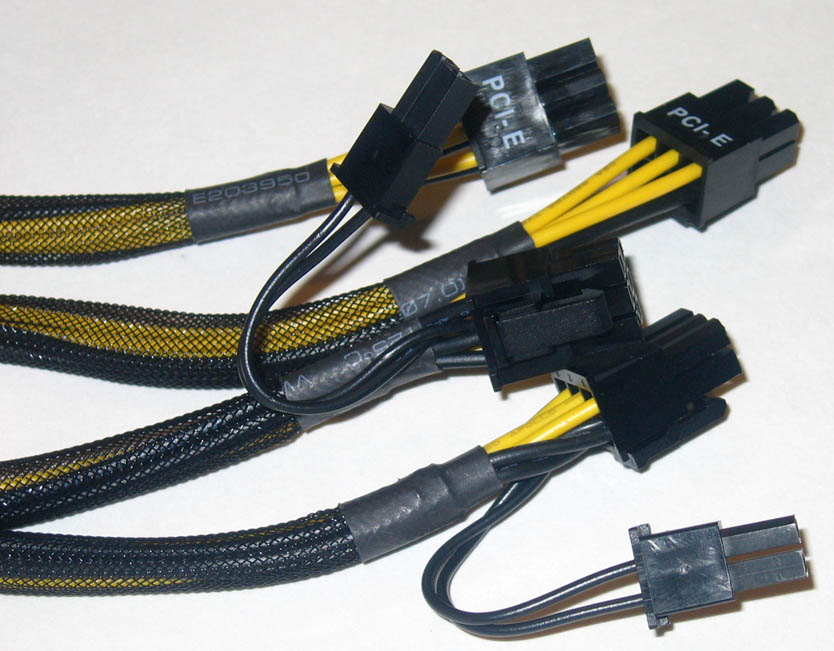
Under the Hood
Although the single 80mm ADDA fan specifications are already given by PC P&C in the specifications table on page 2 (Didn’t I say that before?) here is the obligatory photo of the fan itself.
These two pictures best show the space gap between the front intake of the fan and the internal components. According to PC P&C the extra length of the unit is to give the fan a mostly unobstructed zone for smooth airflow. Doing so would allow for more even airflow through the unit and less fan noise during operation, which we will be checking later.
Another thing I have noticed is the two rather large aluminum heatsinks. The Quad Silencer is the same height as any other power supply, so anyone can imagine what would happen to the size of those heatsinks if a 120mm or 140mm size fan was used on this unit. The heatsinks would have to be pretty small, right? Well unfortunately in the average 120/140mm fan equipped power supply they are. The two extruded aluminum heatsinks are also longer than normal PSU heatsinks, the all around additional size is likely the best explanation as to how the Quad Silencer is able to get away with the use of just a single 80mm fan despite the higher total power and larger mass of the unit.
As a reviewer I would be remiss to not nitpick, so again another detail to point out is the jumbled mess of wires. The above image is a stock reference photo of this same power supply, however there is obviously not as clean a wiring job in the actual unit. The more honest explanation is likely because PC P&C has added more than a few extra wires since the original stock photo was taken. But regardless of the “why”, the issue is this will create a hot pocket by severely restricting airflow through this side of the unit.
TEST METHODOLOGIES
It is important to pause here and make a note of power supply testing methodologies. I would be doing a disservice to our readers if I neglected to mention this point. As Bjorn3D does not have the resources to afford a full scale PSU load tester (such as PC P&C’s in house Chroma 8000 ATE) the best we can currently offer is to load down our individual testing platforms to as close as possible to match the specific power supply’s total rating. This is a grossly ineffective way to test a power supply!
Only partially loading a power supply does not tell us anything other than the power supply will function at half load under the same specific conditions. Power conditions will always be different, currently I measure around 118VAC from the wall socket but our readers could have anywhere from 100 to 240VAC depending on location, conditions of their local power grids, or simply what they have running off the same wall outlet at any given time. Environment temperature further changes these numbers, always for the worse as the temperature goes up. Often the worst case scenario is a PSU running from a 100VAC outlet in a 50c temperature case under a 100% load. These different input voltages can and will drastically change any power supply’s performance and overall efficiency, but this can only be tested with equipment such as a Chroma 8000. What is so special about these machines is they will allow for precise input power configurations and can then measure the exact output given by the PSU itself.
TEST SETUP
The PC Power & Cooling 750 Watt Quad Silencer was installed in a high-end gaming rig with the usual surfing, gaming, overclocking and similar usage that it can likely expect from an enthusiast system. I quickly realized a E6300 was not going to be anything other than a power miser even at 3.8GHz. Only then did the fun begin, the E6300 was swapped for something meatier, namely a quad-core Q6600. With the Q6600 overclocked to a standard 3GHz the system was run 24/7 for over a month under a constant 100% load ensured by Folding @Home, only interrupted by occasional reboots. These conditions are not kind as other power supplies without Active PFC that I could name (but won’t) would tend to grow very hot even in a well ventilated case when approaching these conditions. To the Quad Silencer’s credit it did not even grow more than slightly warm despite the smaller 80mm fan when the “other” power supplies had 120mm fans.
| Test Platform | |
| Processor | Intel Q6600 Core 2 Quad @ 3.74 GHz 1.42V (G0 Revision) |
| Motherboard | Gigabyte GA-P35-DQ6 (F6 BIOS, Revision 1.0) |
| Memory | 2GB Crucial Ballistix PC2-8500 (1067MHz, 2.2V) |
| Drives |
4 – Seagate 320GB Barracuda SATA Drives (RAID 10)
Lite-On DVD-RW SATA drive
|
| Graphics | FOXCONN 8800 GTS 320mb (650/1503/1952 MHz) |
| CPU Cooling |
Swiftech Apogee GT Waterblock
Swiftech MCP655 Pump
Koolance EHX-1050BK Radiator
|
| Case Cooling | 10 – 120mm fans total @ full |
| Power Supply | Test Item # 1: PC Power & Cooling 750 Watt Quad Silencer |
| Case | Antec P180-B |
| Operating System | Windows Vista Ultimate x32 |
Before measurements were recorded the test platform was pushed to the absolute maximum limits with the use of a higher CPU+GPU overclock and a combination of ATI Tool, Orthos, Prime95V2, and finally WinAmp to play back one of those old fashioned music CDs. The idle power results were taken with Windows sitting at the desktop after 5 minutes of zero load. The system was then fully loaded for 30 minutes before load power and thermal measurements were taken.
An Extech 470 combination multimeter/IR thermometer in conjunction with a Kill-a-Watt P3 power meter were used for measurements. All voltage readings were taken from the back of the main 24-pin connector only in order to give the most accurate results. Thermal measurements were taken from the exhaust fan. No hardware or software mods whatsoever were used, no second GPU was used in the second PCIe slot, not even a sound card was installed. The monitor and speakers are not included in the power figures.
TEST RESULTS
The rows for “watts used” and “input power” are a best approximation of the average and not finite figures, since the wattage range was in a state of constant flux. The rough average power draw fell inside the 600-610 watt range with frequent spikes above and below that range, with the highest recorded peak reaching a brief 627 watts and the lows dipping to about the 583 watt range as individual CPU cores paused to page to RAM.
| PC Power & Cooling 750W Quad Silencer | ||||
|
|
||||
|
Idle |
Load |
|||
| 3.3V | 3.37 | 3.37 | ||
| 5V | 5.01 | 4.99 | ||
| 12V | 12.03 | 12.00 | ||
| Watts Used | 370W | 606W | ||
| Input Power | 3.12A*118V | 5.17A*117.9V | ||
| PF | 0.99 | |||
| Ambient Temp | 26C | |||
| Exhaust Temp | 37C | 42C | ||
I believe I asked some questions at the very start of this review asking if a single CPU and single GPU system was capable of even drawing a 620 watt load, let alone 750 watts from the wall. Well technically that is both a yes and a no, and here is why.
When measuring the power going into the power supply we are effectively measuring the total power draw, not what the computer itself is using. This is a key difference to note, given the Quad Silencer’s 83-85% efficiency rating it means 15-17% of the 606 watts measured (91-103 watts) was lost in the AC to DC conversion process. Therefore assuming an extremely good efficiency rating of 15% the computer itself only was using 515 watts. Not many reviews will make this distinction and only stick with the total power consumed from the wall. Without the proper test equipment to analyze both the input and output of the power supply the exact efficiency cannot be measured. So long story short, the entire load did peak above 620 watts but the actual load from the system remained a little over 500 watts.
Interestingly the results were even better than the first that were taken with an E6300, which are not shown here. As the power load increased past the maximum point I could attain with the E6300 the voltage rails went from slightly above to almost exactly ATX specifications. In other words as the power supply load changed from 60% to 80% the voltage rails fell closer to perfect specs, showing that the Quad Silencer is optimally tuned towards a 60-80% load range. It would appear that a higher load would have been likely to cause the voltage rails to drop to just marginally below perfect 3.3V, 5V, and 12V specifications. Unfortunately as I stated at the start of this page these results in of themselves are not an effective way to judge a power supply, especially since the highest achievable load was only about 80% of the Quad Silencer’s total rated capacity.
Regarding the “Silence” part of the Quad Silencer name I do not have a decibel meter to give quantitative results by, only my (claimed inaccurate) purely subjective hearing. At idle the unit was not audible even with the din from all the other case fans briefly tempered. As the load neared 80% the single fan increased its speed and the whoosh of airflow could barely be heard, however there were no tonals, clicks, or other audible sounds that I could hear, again with the case fans briefly quieted. Everyone’s hearing is different so my hearing analysis might as well be hearsay. I will simply conclude with that to my own ears I would rate the unit highly for its near complete silence.
I will include some extra figures for those curious about the high power consumption of this system. Switching from a E6300 to a Q6600 CPU (both running at 3.74GHz) resulted in an astonishing extra roughly ~150 watts of power consumption. Overclocking the Q6600 beyond 3GHz quickly turned a power efficient chip into a power monster that could hark back to the Netburst days of yore. Simply adding two Delta 152CFM fans and turning all case fans to their highest speed was not only deafening but also had a significant impact on total power draw, one could almost say I was literally blown away. Turning the Swiftech MCP655 Pump to max also contributed to the admittedly unusually high power consumption figures for this test rig. However had a full 8800GTX, let alone a HD 2900XT or 8800Ultra been used the power consumption could easily have blown past the 750 watt mark (drawn from the wall) and still just with a single GPU!
CONCLUSION
The start of this article questioned the need for such a powerful power supply for those users that are content with just a single bleeding edge GPU and CPU. The answer is yes, there is a need and it is not a simple explanation of marketing hype. Overclocking played a key role in dramatically changing a power efficient computer into a power hungry beast, and had a HD 2900 or 8800GTX/Ultra been utilized the test platform could have reached a mind numbing 750 watts of power consumption. Two quad-core processors on a modified server motherboard with 4GB RAM and anywhere from two-to-four GPUs such as AMD’s V8 and Intel’s Skulltrail are not the only power inefficient platforms. Overclocking and a few extra overlooked components such as hard drives, sound cards, PPUs, water cooling or more exotic cooling solutions such as peltiers can quickly add up as fast as the fuel prices at the local filling station.
The PC Power & Cooling 750 Watt Quad Silencer may not be an easy fit in some cases if it can fit at all. However the larger design has allowed for much larger than usual heatsinks, which do an admirable job at making the most of the 80mm fan’s airflow. The added spacing for the fan has also ensured there is zero uneeded baffle noise generated from components placed to close to the fan blocking airflow.
While I am admittedly biased I would still highly recommend the additional 12-Point Certified Test Report. This report is in fact more valuable than many power supply reviews because it will test the maximum load across all rails, hold up time, efficiency, ripple, and peak output amongst other key tests. The only things it does NOT cover are variable environment temperatures and a full gamut of input VAC conditions as these variables will directly change the results of all conducted tests. Even so almost every test has been included and the data is very imformative. If the photos of the report included for this test power supply are not clear enough PC Power & Cooling has a sample Quad Silencer report available here in PDF format.
If anything the included certification with the review sample Quad Silencer should be as telling as this review itself. I was only able to place an 80% load on the 750 watt Quad Silencer however it performed admirably through every situation it was put through including not so stable input voltages. For those readers looking for more concrete data on the Quad Silencer’s performance I highly suggest giving a read through the 12-Point Certified Test Report specific to this power supply that is shown on page 3.
No review would be complete without critiques and suggestions on areas that could possibly be improved. While modular cabling is a topic of hot contention for many valid reasons I am not so sure I can fully believe the explanation given on PC P&C’s excellent Power Supply Myths Exposed article. Regardless, offering a variant of the Quad Silencer modified for modular cabling for those that prefer it over its disadvantages might be an option to consider. Also a case badge or velcro straps to manage the slew of cables would of been useful. Lastly not to complain but PC Power & Cooling has been building power supplies for 20 years with the same 4-pin molex connector; the use of any variant of the quick-disconnect molex connectors would likely be appreciated by everyone for easy work within the computer case.
There are no frills with the PC Power & Cooling 750 Watt Quad Silencer, especially with the matte black version. No giant LED fans, modular cabling, glitz, glitter, or bling. The approximately $170 price is directly on par with other similar 750 watt power supplies, instead of the bling you will only receive a higher commitment to a quality product above else. In reality $170 for the overall quality, assured attention to almost every detail from product design to the packaing to the now 5-Year end user warranty ensure that you receive a quality experience before, during, and after the 750 watt Quad Silencer reaches your front door. PC Power & Cooling’s Quad Silencer won’t dazzle you with features, but it will likely dazzle you all the same with its sheer reliability and solid performance.
Pros:
+ 80%+ Efficiency Certification
+ Dual Next Generation 8-pin (2×4-pin) PCIe connectors
+ Sleeved cables
+ Virtually silent
Cons:

 Bjorn3D.com Bjorn3d.com – Satisfying Your Daily Tech Cravings Since 1996
Bjorn3D.com Bjorn3d.com – Satisfying Your Daily Tech Cravings Since 1996
